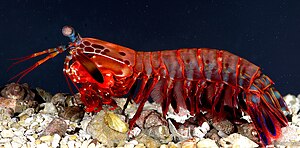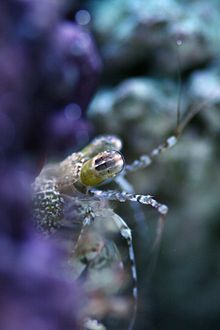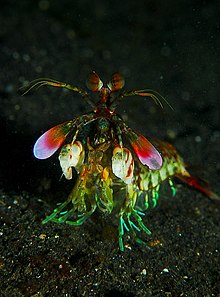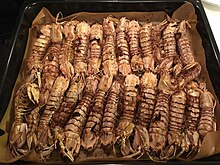Mantis shrimp
| Mantis shrimp | ||||||||||||
|---|---|---|---|---|---|---|---|---|---|---|---|---|

Odontodactylus scyllarus |
||||||||||||
| Systematics | ||||||||||||
|
||||||||||||
| Scientific name of the subclass | ||||||||||||
| Hoplocarida | ||||||||||||
| Calman , 1904 | ||||||||||||
| Scientific name of the order | ||||||||||||
| Stomatopoda | ||||||||||||
| Latreille , 1817 |
The mantis shrimp (Stomatopoda) are an order of the Higher crabs (Malacostraca). They owe their name to their fishing tools, the externally those of mantis are similar (mantids). To date, around 400 species have been described worldwide.
Mantis shrimp live as predatory lurkers in the bottom zone of tropical seas. As far as known so far, many species are solitary ; but about Odontodactylus brevirostris it says z. B. “She often lives in loose groups close to her fellow species. The animals are promiscuous, and males mate with multiple females ”. Some live monogamous in pairs. It is said of Pseudosquilla ciliata , "Females are sexually aggressive and often beg or even force males to copulate ". Mantis shrimp have highly developed eyesight with unusually powerful complex eyes. A distinction is essentially made between “spears” and “butterflies” when hunting them. Some smashes can be particularly violent. Occasionally, hits from carelessly grasping butterflies are said to have made the subsequent amputation of a finger necessary.
features
Mantis shrimp have the general blueprint of the ten-footed crabs , which is, however, modified in a characteristic way. The rear part of the body ( pleon or abdomen) is more developed than the front part (the cephalothorax ) compared to most groups. The carapace is shortened and does not completely cover the trunk section, it only covers the back of the head and the first segments of the thorax . Behind it is a movable free thorax, so that the body appears to be made up of three, not just two, sections. The body is always elongated and usually somewhat flattened from top to bottom (dorsoventral).
Some species grow up to 30 cm long; most are smaller.
Cephalothorax
The cephalothorax of the mantis shrimp consists of the head section and five trunk segments, which are covered together by the carapace. The head carries the eyes and the typical five pairs of extremities of the crustaceans: first and second antennae, mandibles and first and second maxillae. The extremities of the trunk segments of the cephalothorax are transformed in the service of ingestion and are called maxillipedas. So you have five pairs of maxillipeds. As a special feature within the higher crustaceans, the carapace is not continuous, but the front section of the head and the segment of the first antennae are pinched off and can move against each other at the seam. When viewed from above, three tergites can be seen in front of the fused cephalothorax, a short medial plate in front of the eye stalks and an ocular plate at their level, which has two ear-like extensions, the eyelids, which protect the stalked eyes. Behind it sits a mostly triangular or trapezoidal rostral plate. The large, shield-shaped carapace is divided into three sections by longitudinal furrows. The eyes of the mantis shrimp are always petiolate and very mobile, their sensory part (cornea) is usually somewhat kidney-shaped and constricted in the middle, thus consists of three zones of differently shaped ommatidia; these enable spatial vision when catching prey (see below section complex eyes).
The first antennae always carry three separate flagella. The shape of the second antenna is again very characteristic. Your endopodit forms a three-part flagellum, the exopodit is two-part with a short base member and a leaf-like widened end member, the edge of which is usually covered with feather bristles. The mandibles have a cutting region (incisor), a chewing surface (mola) and a slim feeler (palpus). The second maxillae are widened leaf-shaped. These mouth limbs are followed by five thoracopods, the maxillipedas, which have been reshaped to serve food intake. All maxillipedas of the mantis shrimp are designed as scissors in the form of a subchela, in which a pocket knife-like movable scissor finger can be folded against a solid base member. In contrast to the basic construction plan of the Malacostrac, they do not consist of seven, but only six segments. Outside there is a small, leaf-shaped appendix (epipodite) that serves as a gill. The first maxillipedas are always built gracefully and serve as cleaning legs.
The greatly enlarged second maxillipedas, which are redesigned as catching legs when prey is acquired, are highly characteristic of the group (see section "Butterflies" and "Spears" below). The last three limbs are slim and can be folded like scissors compared to the first three with strong muscles. There are two variants: In the case of the “spears”, the pointed, dagger-like end links of the unfolded subchela are rammed into the prey and impaled in this way, they usually carry numerous pointed bristles for support. The closed subchela is used like a hammer in the "Butterflies".
Maxillipedas three to five are again significantly smaller; they are used to move and manipulate food.
thorax
The free trunk section (thorax) consists of the rear four segments of the trunk, which are separated from one another by seams and can be moved against one another. It forms an articulated region between the stiff cephalothorax and pleon, which gives the animal increased mobility, for example when turning in the underground structures. The torso legs (thoracopods) of the mantis shrimp are typical split legs . The base section (protopodite) is divided into three sections (precoxa, coxa, base). An endopodit made up of four sections sits on it. Only the last three pairs of legs of the thorax (six to eight on the trunk segments) form typical striding legs (peraeopods) in the mantis shrimp. The fifth segment is greatly shortened and has very short extremities. The upper side is usually smooth, in some families it has conspicuous longitudinal keels or edges.
Pleon
The mantis shrimp pleon consists of six segments and a very large telson . The extremities of the pleon segments, the pleopods, are wider than the peraeopods of the trunk. At their base are externally feathered gills. The tergites of the upper side are, like the thoracic segments, either smooth or longitudinally keeled, depending on the genus. The side sections of the first segment carry laterally movable appendages, the pleural plates, which are important for the determination. The pleopods consist of a base member and widened endo- and exopodites, which have gills (branchiae) on the outside. In the males, the endopodit of the first pleopods is transformed into a mating organ (petasma). The pleopods of the sixth segment are designed differently with leaf-like widened limbs, they are called uropods . In one family (Protosquillidae) the sixth pleon segment is fused with the telson. The telson is flattened and has numerous ribs, keels and thorns, the shape of which is essential for species identification. Together with the uropods, it forms a tail fan that allows the animals to suddenly catapult backwards when they escape.
Antennas and telson reflect polarized light.
Colors and reflection colors
Mantis shrimp come in a variety of colors, from unobtrusive browns to bright neon colors . Iridescent patterns on the body surface serve to exchange signals among some species.
Complex eyes

Her eyes , perched on stems, are independently mobile and highly developed. Because of their relatively small field of vision, mantis shrimp keep their eyes constantly moving to observe their surroundings.
Your compound eyes are usually divided into three parts: They consist of an upper section, a median strip (usually six rows of ommatidia wide) and a lower section. Due to the shape of the eyes, the fields of view of the upper and lower sections overlap , as can also be seen from the recognizable pseudopupils . This enables separate spatial vision with each complex eye. Eyes that are not divided include B. Neogonodactylus curacaoensis .
The ommatidia of the median are specialized in the perception of different light qualities. Some species differentiate between up to 12 color channels , some in the UV range, and can differentiate differently polarized light, including circularly polarized light. The surroundings are perceived in the overlapping visual area by each eye on several channels in parallel (spatial, color, UV, polarization).
Mantis shrimp can use the perception of the sky polarization pattern to orientate themselves in their habitat.
Way of life
Mantis shrimp live predatory and are mostly territorial loners, mostly hidden in the benthos of tropical seas between rocks and stones or in complex duct systems in the sand of the seabed for prey . If possible, they only leave their hiding places to look for food or to move to a new hiding place and are mostly nocturnal.
Reproduction and Life Expectancy
All mantis shrimp are separate sexes. Some species are monogamous , others separate after mating or look for another mate.
The females practice very intensive brood care by cementing up to 50,000 eggs and carrying them around for up to 10 weeks. During this time they refrain from eating. The eggs hatch almost transparent larvae with largely developed limbs, which spend the first three months in a pelagic state.
The animals usually live for several years, for Harpiosquilla raphidea (Fabricius 1798) 6.7 to 8.5 years were determined and can reproduce up to 30 times in their lifespan.
Internal communication
Mantis shrimp have a complex social behavior, which is particularly evident in territorial disputes: They react promptly to intruders, but mostly communicate with pennant-like appendages on their heads, so that deadly territorial fights do not occur. These vehemently moving appendages, antennas and telsa reflect particularly well polarized light, which the crabs can easily recognize.
"Smashers" and "Spears"
It is to "Schmetterern" ( English "smashers") and "Speerern" (English "spearers") differed.
Squilla mantis : a "spear", clearly visible the pointed fangs
"Butterflies"
The crabs (e.g. Odontodactylus scyllarus ) hook parts of their exoskeleton to smash , tense the strong muscles and then let the tentacles snap forward in an explosive movement. The battering leg of the mantis shrimp develops a speed of 23 m / s (corresponds to 82.8 km / h); the accelerations that occur are up to 8000 times the acceleration due to gravity. A human blink takes about 40 times as long as this leg movement. This blow is one of the fastest movements an animal can make. The impact force is similar to that of a pistol bullet. However, the cancer only develops its full power with the help of gas bubbles. When the hammer arms move through the water at high speed, they create a high negative pressure. Tiny gas bubbles form, which then implode, releasing a great deal of energy ( cavitation ). This creates a bang and sometimes even a flash of light . The victim is stunned by the blow. The impact of the hammer legs is violent enough to shatter the shells or shells of marine animals, experts in aquariums also report broken glass.
The clubs of mantis shrimp (e.g. Odontodactylus scyllarus ) are made up of three different layers, which means that these high forces withstand an impact on an object without damage. The top, heavily mineralized layer of the clubs in the area of the impact surface consists of crystallized hydroxyapatite and the biopolymer chitin . The layer arranged underneath serves to avoid the formation of cracks and also consists of chitin, which is arranged there in mutually rotated stacks, and an amorphous mineral matrix. A third fiber layer is located on the sides of the clubs and serves to dampen the forces acting on an object by tightening the entire structure. It has been known since 2020 how the outer protective layer of the club made of hydroxyapatite crystals in an organic matrix contributes to damping; the crystal particles can shift or break at the edges and thus absorb energy.
A similar behavior is also known from crack shrimp (Alpheidae), also known as pistol shrimp.
"Spear"
In “spears” (e.g. Harpiosquilla raphidea (Fabricius 1798), Squilla empusa ), the end links of their legs are clearly pointed. With these they can pierce prey.
Distribution areas
Most of the species live in the benthos of tropical and subtropical seas, for example off Florida and California , or around Thailand , but there are also species in colder areas, e.g. B. in the Mediterranean.
Systematics
The following system includes the fossil and recent groups, down to the family level. All recent species belong to the suborder Unipeltata. Both Palaeostomatopoda and Archaeostomatopodea are presumably paraphyletic root groups and are integrated into the, expanded, Unipeltata by many more recent authors.
Hoplocarida
- † order Aeschronectida
- † Aenigmacarididae Schram & Horner, 1978 ( Carboniferous , North America and Great Britain)
- † Aratidecthidae Schram, 1979 (with the only species Aratidecthes johnsoni Schram, 1969) (Karbon, North America)
- † Kallidecthidae Schram, 1969 (Carboniferous, North America, Great Britain, continental Europe: Czech Republic)
- Order stomatopoda
- † Subordination "Palaeostomatopodea" (presumably paraphyletic parent group)
- † Perimecturidae (Carboniferous)
- † Archaeocarididae ( Devonian )
- † Subordination "Archaeostomatopodea" (probably paraphyletic parent group)
- † Tyrannophontidae (Carboniferous)
- † Daidalidae (Carboniferous)
- † Gorgonophontidae (Carboniferous)
- Subordination Unipeltata
- Squilloidea
- Eurysquilloidea
- Parasquilloidea
- Bathysquilloidea
- Erythrosquilloidea
- Lysiosquilloidea
- Gonodactyloidea
- † Sculdidae ( Jurassic to Cretaceous )
- † Pseudosculdidae ( Upper Cretaceous )
- † Subordination "Palaeostomatopodea" (presumably paraphyletic parent group)
use
In Japanese cuisine, mantis shrimp are called shako , while Italian cuisine calls them canocchie or cicali di mare . The animals are also very popular in Chinese cuisine and are known as "piss crabs" because they usually urinate during the cooking process. They are therefore skewered before cooking so that the bladder is emptied before cooking . The cooked meat tastes similar to that of a lobster .
literature
- Frederick R. Schram; Shane T. Ahyong; Sheila N. Patek; Patrick A. Green; Michael V. Rosario; Michael J. Bok; Thomas W. Cronin; Kristina S. Mead Vetter; Roy L. Caldwell; Gerhard Scholtz; Kathryn D. Feller & Pere Abelló: Subclass Hoplocarida Calman, 1904: Order Stomatopoda Latreille, 1817. In: Treatise on Zoology - Anatomy, Taxonomy, Biology. The Crustacea, Volume 4 Part A . Chapter 49, pp. 179-355, Brill Online Books and Journals, 2013, Chapter doi : 10.1163 / 9789047440451_006 E- ISBN 9789047440451 .
Broadcast reports
- Joachim Budde: BIOLOGY - The slightly different eyes - The super eyes of the mantis shrimp , in Deutschlandfunk - “ Research News ” from January 24, 2014.
Web links
- Fangschreckenkrebse.de . private page of Timmy Grohrock
- ITIS Report Online query from “Hoplocarida”. Integrated Taxonomy Information System, accessed February 26, 2010 .
- Video of the eye movement of a mantis shrimp
Individual evidence
- ↑ a b c d Jennifer L. Wortham-Neal: Intraspecific agonistic interactions of Squilla empusa (Crustacea: Stomatopoda) . In: Behavior . 139, No. 4, 2002, pp. 463-486. doi : 10.1163 / 15685390260135961 .
- ↑ Debelius, H., Cancer Guide Worldwide: Shrimps, Crabs, Lobsters, Lobsters, Mantis Shrimp, Jahr-Verlag, Hamburg 2000, ISBN 3-86132-504-7 , p. 280
- ↑ H. Debelius: Cancer Guide Worldwide: Shrimps, Crabs, Lobsters, Lobsters, Mantis Shrimp. Jahr-Verlag, Hamburg 2000, ISBN 3-86132-504-7 , p. 290.
- ↑ Debelius, H., Cancer Guide Worldwide: Shrimps, Crabs, Lobsters, Lobsters, Mantis Shrimp, Jahr-Verlag, Hamburg 2000, ISBN 3-86132-504-7 , pp. 268-293
- ^ A b c S. N. Patek, RL Caldwell: Extreme impact and cavitation forces of a biological hammer: strike forces of the peacock mantis shrimp Odontodactylus scyllarus . In: Journal of experimental biology . 208, No. 19, 2005, pp. 3655-3664. Retrieved March 13, 2013.
- ↑ H. Debelius: Cancer Guide Worldwide: Shrimps, Crabs, Lobsters, Lobsters, Mantis Shrimp. Jahr-Verlag, Hamburg 2000, ISBN 3-86132-504-7 , p. 278.
- ↑ Carel von Vaupel Klein, Mireille Charmantier-Daures (editors): Treatise on Zoology (Traité de Zoologie) - Anatomy, Taxonomy, Biology. The Crustacea. Volume 4, Part A. Brill Academic Publishers, Leiden and Boston 2013. ISBN 978-90-04-17809-0 . therein Subclass Hoplocarida, Order Stomatopoda (Frederick R. Schram et al.), Shane T. Ahyong: External Morphology (pp. 180-201).
- ↑ a b c d e Justin Marshall, et al. : Behavioral evidence for polarization vision in stomatopods reveals a potential channel for communication . In: Current Biology . 9, No. 14, July 15, 1999, pp. 755-758. doi : 10.1016 / S0960-9822 (99) 80336-4 .
- ↑ Debelius, H., Cancer Guide Worldwide: Shrimps, Crabs, Lobsters, Lobsters, Mantis Shrimp, Jahr-Verlag, Hamburg 2000, ISBN 3-86132-504-7 , p. 276.
- ↑ Ultraviolet vision: The colorful world of the mantis shrimp . October 28, 1999. Retrieved December 28, 2010.
- ↑ Tsyr-Huei Chiou, Sonja Kleinlogel, Tom Cronin, Roy Caldwell, Birte Loeffler, Afsheen Siddiqi, Alan Goldizen, Justin Marshal: Circular Polarization Vision in a Stomatopod Crustacean . In: Current Biology . March 18, 2008, p. 429. doi : 10.1016 / j.cub.2008.02.066 .
- ↑ Yusli Wardiatno, Ali Mashar: Population Dynamics of the Indonesian Mantis Shrimp, Harpiosquilla raphidea (Fabricius 1798) (Crustacea: Stomatopoda) Collected from a Mud Flat in Kuala Tungkal, Jambi Province, Sumatera Island . In: ILMU KELAUTAN: Indonesian Journal of Marine Sciences . 16, No. 2, 2012, pp. 111-118. Retrieved March 13, 2013.
- ↑ Deadly strike mechanism of a mantis shrimp (PDF; 348 kB) August 26, 2004. Accessed July 26, 2011.
- ↑ a b c d e f The cancer with the deadly hammer. Biology. In: SPIEGEL Online. Spiegel Online GmbH, June 8, 2012, accessed June 9, 2012 .
- ↑ James C. Weaver, Garrett W. Milliron, Ali Miserez, Kenneth Evans-Lutterodt, Steven Herrera, Isaias Gallana, William J. Mershon, Brook Swanson, Pablo Zavattieri, Elaine Di Masi, David Kisailus: The Stomatopod Dactyl Club: A Formidable Damage-Tolerant Biological Hammer . In: Science . tape 336 , no. 6086 , 2012, p. 1275–1280 , doi : 10.1126 / science.1218764 (American English).
- ↑ Wei Huang, Mehdi Shishehbor, Nicolás Guarín-Zapata, Nathan D. Kirchhofer, Jason Li, Luz Cruz, Taifeng Wang, Sanjit Bhowmick, Douglas Stauffer, Praveena Manimunda, Krassimir N. Bozhilov, Roy Caldwell, Pablo Zavattieri, David Kisailus (2020 ): A natural impact-resistant bicontinuous composite nanoparticle coating. Nature Materials, online before print doi: 10.1038 / s41563-020-0768-7
- ↑ Shane T. Ahyong & Christine Harling (2000): The phylogeny of the stomatopod Crustacea. Australian Journal of Zoology 48 (6): 607-642.
- ↑ Frederick Schram & Mireille Charmantier-Daures: Treatise on Zoology - Anatomy, Taxonomy, Biology. The Crustacea, Volume 4 Part A. Brill Scientific Publishers ISBN 978-90-04-17809-0
- ↑ Joachim T Haug, Carolin Haug, Andreas Maas, Verena Kutschera, Dieter Waloszek Evolution of mantis shrimps (Stomatopoda, Malacostraca) in the light of new Mesozoic fossils. BMC Evolutionary Biology 2010, 10: 290, doi: 10.1186 / 1471-2148-10-290 (open access).







